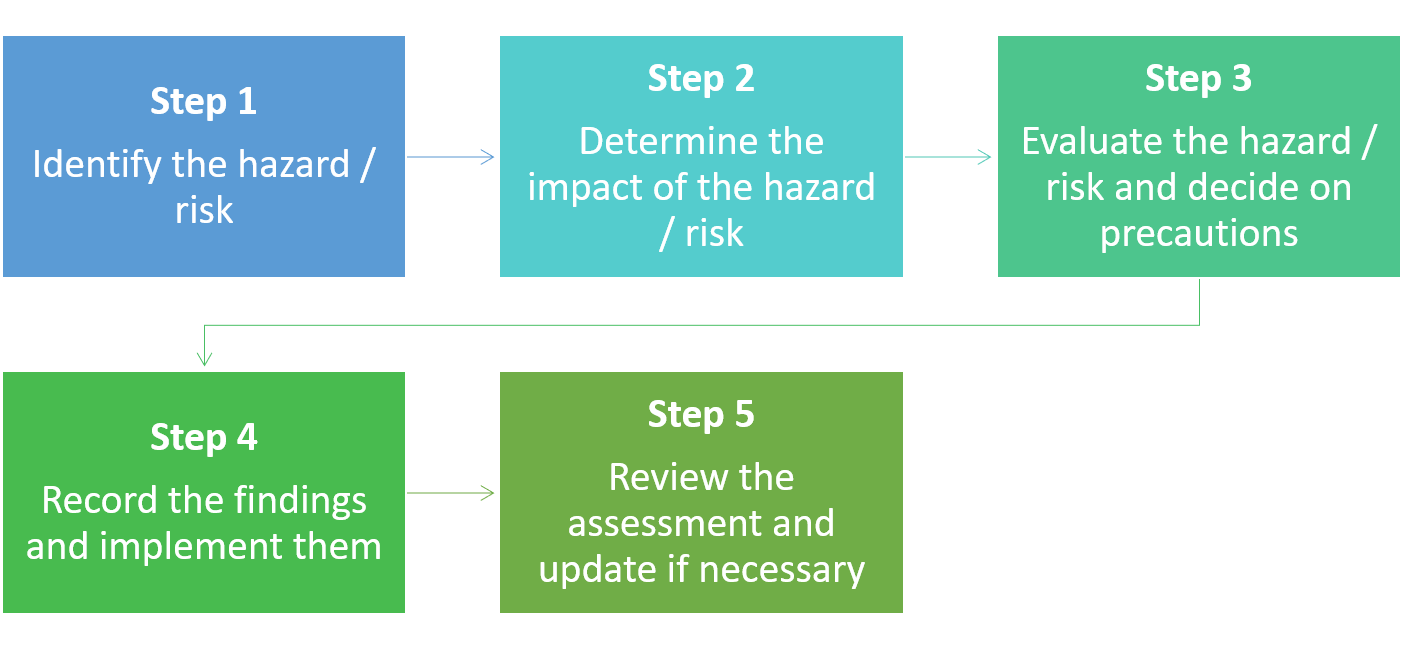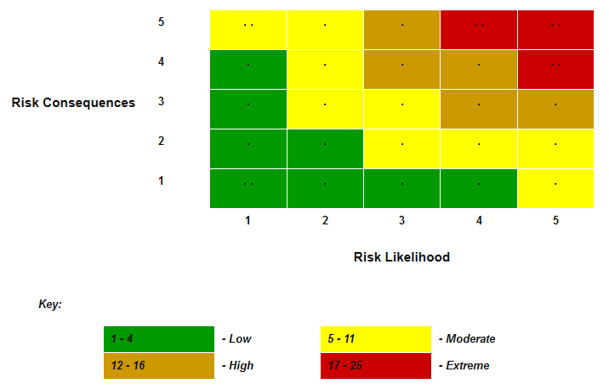Managing Risks
To manage risks in your workplace, follow the five steps below.

Do not overcomplicate the process. In many organisations, the risks are well known and the necessary control measures are easy to apply. If you are not confident, get help from someone who is competent. In all cases, you should make sure that you involve your team in the process. They will have useful information about how the work is done that will make your assessment of the risk more thorough and effective. But remember, you are responsible for seeing that the risk is assessed and precautionary actions taken.
When thinking about your risk assessment, remember:
General Principles To Follow
The following general principles should be followed when conducting a risk assessment:
- All relevant risks and/or hazards should be systematically addressed.
- The aim is to identify the major risks in the workplace and not obscure those risks with an excess of information or by concentrating on minor risks.
- Be systematic in looking for risks. Remember that risk assessment is a process.
- It should be ensured that all aspects of the work activity are reviewed.
- The risk assessment should address what actually happens in the workplace during the work activity.
- Actual practice may differ from what is supposed to happen in written instructions, procedures, etc. This is frequently the way risks creep unnoticed into an operation.
- Especially consider non-routine operations. For example, maintenance operations and changes in methods of work.
- Pay attention to interruptions or changes to the workplace. Changes need to be carefully managed.
- All employees and those who may be affected must be considered, including maintenance staff, security guards, visitors and contractors.
- The risk assessment process should take into account the existing precautionary measures and controls, for example, codes of practice, procedures, guards, special instructions and so on. These may not be working properly. It is particularly important that this is objectively assessed.
- The level of detail on a risk assessment should match the level of risk. The purpose is not to deal with every minor risks. A suitable and sufficient risk assessment reflects what employers might reasonably foresee in terms of hazard in their workplaces.
In most cases, it is better first to make a rough assessment to prioritise the risks. Then, in the second assessment, more sophisticated techniques can be used to deal with the major risks.
Step 1 – Identify The Hazards/Risks
A risk assessment is simply a careful examination of what, in your work, could cause harm to people, or harm your business so that you can weigh up whether you have taken enough precautions or should do more to prevent harm.
Step 2 – Risk Prioritisation
The matrix below can be used to record a priority rating for each risk identified in the assessment. Each risk identified must be evaluated in terms of:
- The probability of occurrence (the likelihood).
- The severity of the consequence should the risk actually occur.
A risk exposure that has both a high likelihood and a high severity of consequence should be given the greatest consideration for elimination or control. A risk that is both low in likelihood and low in severity can easily be retained and self-funded.
If an evaluation of a risk gives rise to a rating of "Extreme", it must be dealt with straight away.

Risk Rating Descriptions
|
E |
Extreme Risk |
Not acceptable Likely to threaten the survival or continued effective functioning of the program or the organisation, either financially or politically. Immediate action required |
|
H |
High Risk |
Generally not acceptable Likely to cause some damage, disruption or breach of controls Senior management attention needed and management responsibility specified |
|
M |
Moderate Risk |
Acceptable Unlikely to cause much damage and/or threaten the efficiency and effectiveness of the program/activity Treatment plans to be developed and implemented by operational managers Manage by specific monitoring or response procedures |
|
L |
Low |
Acceptable Unlikely to require specific application of resources; Manage by routine procedures Monitor and review |
Residual Risk Matrix

Calculating The Risk Value
Risk assessment involves the calculation of the magnitude of potential consequences (levels of impacts) and the likelihood (levels of probability) of these consequences to occur.
Risk = Consequence x Likelihood
The C × L matrix method therefore combines the scores from the qualitative or semi-quantitative ratings of consequence (levels of impact) and the likelihood (levels of probability) that a specific consequence will occur (not just any consequence) to generate a risk score and risk rating.
Essentially, the higher the probability of a "worse" effect occurring, the greater the level of risk.
This C x L risk assessment process involves selecting the most appropriate combination of consequence and likelihood levels that fit the situation for a particular objective based upon the information available and the collective knowledge of the group involved in the assessment process.
Step 3 – Decide On Precautions
Having spotted the hazards/risks, you then have to decide what to do about them. The law requires you to do everything reasonably practicable to protect people from harm. You can work this out for yourself, but the easiest way is to compare what you are doing with good practice. There are many sources of good practice that can help. First, look at what you are already doing, think about what controls you have in place and how the work is organised. Then compare this with the good practice and see if there is more you should be doing to bring yourself up to standard. In asking yourself this, consider:
- Can I get rid of the hazard/risk altogether?
- If not, how can I control the risks so that harm is unlikely?
When controlling risks, apply the principles below, and if possible, in the following order:
- Try a less risky option (e.g. switch to using a less hazardous chemical).
- Prevent access to the hazard (e.g. by guarding).
- Organise work to reduce exposure to the hazard (e.g. put barriers between pedestrians and traffic).
- Issue personal protective equipment (e.g. clothing, footwear, goggles etc.).
- Provide welfare facilities (e.g. first aid and washing facilities for removal of contamination).
Improving hazards/risks elimination need not cost a lot. For instance, placing a mirror on a dangerous blind corner to help prevent vehicle accidents is a low-cost precaution considering the risks. Failure to take simple precautions can cost you a lot more if an accident does happen.
Involve staff, so that you can be sure that what you propose to do will work in practice and will not introduce any new hazards.
Step 4 – Record Your Finding And Implement Them
Putting the results of your risk assessment into practice will make a difference when looking after people and your business.
Writing down the results of your risk assessment, and sharing them with your staff, encourages you to do this. If you have fewer than five employees you do not have to write anything down, though it is useful so that you can review it at a later date if, for example, something changes.
When writing down your results, keep it simple, for example: Tripping over rubbish bins provided, staff instructed, weekly housekeeping checks, or fume from welding: local exhaust ventilation used and regularly checked. We do not expect a risk assessment to be perfect, but it must be suitable and sufficient. You need to be able to show that:
- a proper check was made;
- you asked who might be affected;
- you dealt with all the significant hazards, taking into account the number of people who could be involved;
- the precautions are reasonable, and the remaining risk is low; and
- you involved your staff or their representatives in the process.
There is a template at the end of this unit that you can print and use.
If, you find that there are quite a lot of improvements that you could make, big and small, do not try to do everything at once. Make a plan of action to deal with the most important things first. Health and safety inspectors acknowledge the efforts of businesses that are clearly trying to make improvements.
A good plan of action often includes a mixture of different things such as:
- a few cheap or easy improvements that can be done quickly, perhaps as a temporary solution until more reliable controls are in place;
- long-term solutions to those risks most likely to cause accidents or ill health;
- long-term solutions to those risks with the worst potential consequences;
- arrangements for training employees on the main risks that remain and how they are to be controlled;
- regular checks to make sure that the control measures stay in place; and
- clear responsibilities – who will lead on what action, and by when.
Remember, prioritise and tackle the most important things first. As you complete each action, tick it off your plan.
Step 5 – Review Few Workplaces Stay the Same
At some stage you will bring in new equipment, substances, and procedures that could lead to new hazards. It makes sense, therefore, to review what you are doing on an ongoing basis. Every year or so formally, review where you are, to make sure you are still improving, or at least not sliding back.
Look at your risk assessment again. Have there been any changes? Are there improvements you still need to make? Have your workers spotted a problem? Have you learnt anything from accidents or near misses? Make sure your risk assessment stays up to date.
When you are running a business, it is all too easy to forget about reviewing your risk assessment – until something has gone wrong and it is too late. Why not set a review date for this risk assessment now? Write it down and note it in your diary as an annual event.
During the year, if there is a significant change, do not wait. Check your risk assessment and, where necessary, amend it. If possible, it is best to think about the risk assessment when you are planning your change – that way you leave yourself more flexibility.
Click here to download a Risk Management Template